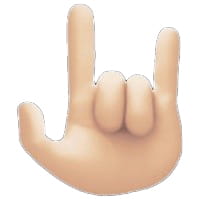What has happened?
- The EUIPO Board of Appeal has upheld a decision to refuse registration of the 🤟 emoji depicted below as an EUTM for financial, real estate and construction services on the grounds that the sign does not meet the threshold for distinctiveness.
- The Board (and the examiner before it) found that the emoji is well-known internationally as meaning 'I love you' and derives from US sign language.
- It therefore conveys a generally positive advertising message that the consumer will be happy with the services offered under the sign. The average consumer might see the sign as decorative or laudatory, but not as an indication of the trade origin of the services in question.
- The fact that the sign depicted the left hand as opposed to the right hand (that used in sign language) was irrelevant since the emoji had been widely used in various forms including with the left hand depicted.
- Although this particular application failed, there is nothing to prevent an emoji (if suitably creative and distinctive) from being registered as a trade mark. Indeed, numerous emojis have been registered worldwide including the smiley face logo. Emojis might also benefit from design or copyright protection.
- Those who wish to use an emoji on their goods/services should investigate the IP position first.

Want to know more?
The EUIPO examiner's decision
A German company filed an EUTM application for a figurative trade mark consisting of the above emoji for a variety of services in class 36 (financial services, real estate services) and class 37 (construction services).
The EUIPO examiner rejected the application in its entirety on the basis that "…the sign is a well-known sign that comes from the US sign language and is now internationally known as an ‘I love you’ handsign.'… The relevant public will therefore simply perceive the sign applied for as a pictogram (emoticon) without distinctive character. … The sign applied for is not capable of making an impression on the consumer, as it is too simple as an emoticon".
This was the case for all services applied for, the EUIPO commenting that, "In this case, the message of the sign in question, as an indication of tongue, is so general that it can refer to all the services objected to, as this is used in such a variety as a purely decorative element or general advertising message that it is incapable, in connection with any category of goods or services, of indicating origin from a particular undertaking."
The applicant appealed the decision to the Board of Appeal (BOA).
BOA Decision
The applicant had conceded that the sign might be an emoji. However, it argued that the sign did not constitute an ‘I Love You’ sign; rather, that it had no clear meaning. The applicant refers to differences between the sign and the ‘I Love You’ emoji and in particular to the fact that the ‘I Love You’ emoji depicts the right hand, whereas the sign in question depicts the left hand.
The BOA maintained the examiner's decision, on the basis that:
- "The examiner had already provided examples which show that there are various variations of the ‘I Love You’ emoji, including ones showing the left hand."
- "In the Board's view 'it follows from this that the public can certainly perceive the sign as the ‘I Love You’ Emoji."'
- "In general, it should be pointed out that the main function of an emoji is to provide emotional references which are otherwise lacking in tilted entertainment. Emojis therefore function as a parallel language, which convey a nuanced meaning and make it easier to express feelings. They are often connected with positive communication. As a rule, they are not perceived as an indication of origin."
-
"In connection with the services objected to, the consumer therefore merely infers from the sign claimed a positive connotation of a general nature, either in the sense of an attractive decoration, in the sense of a general laudatory statement and incitement to purchase. As a simple representation of a positive gesture, the sign does not contain anything that would enable the targeted consumer to assign the goods thus identified commercially."
In summary, the Board found that the mark is not capable of serving to the public as an indication of the origin of the relevant services.
Comment
This decision serves as a useful reminder that the meaning behind marks should be thoroughly considered before seeking registration. It is not only word marks that carry meaning, but imagery, signs and symbols, too. There is a risk that the meaning they carry makes them incapable of functioning as trade marks.
It also serves of a reminder that, despite this decision, some emojis can be (and have been) protected as trade marks (or benefit from design or copyright protection). A careful review of the IP position should therefore be undertaken before using an emoji on goods/services.





